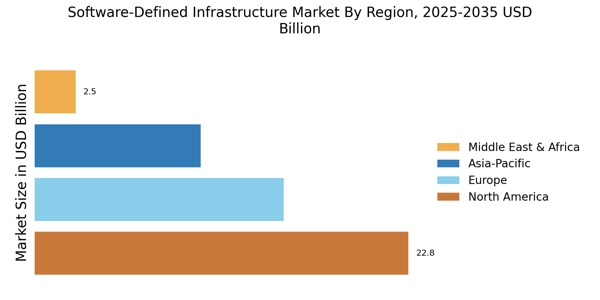Enhanced Security Features
Security remains a paramount concern within the Software-Defined Infrastructure Market. As cyber threats evolve, organizations are compelled to adopt infrastructure solutions that offer robust security features. Software-defined infrastructure provides enhanced security through centralized management and automated policy enforcement, which can significantly reduce vulnerabilities. Recent statistics suggest that companies investing in advanced security measures within their software-defined environments have seen a 30% reduction in security incidents. This trend underscores the importance of integrating security into the infrastructure layer, as organizations strive to protect sensitive data and maintain compliance with regulatory standards.
Rising Demand for Scalability
The Software-Defined Infrastructure Market is experiencing a notable increase in demand for scalable solutions. Organizations are increasingly seeking infrastructure that can adapt to fluctuating workloads and business needs. This demand is driven by the necessity for flexibility in resource allocation, enabling companies to optimize their operational efficiency. According to recent data, the market for scalable software-defined solutions is projected to grow at a compound annual growth rate of approximately 25% over the next five years. This trend indicates that businesses are prioritizing infrastructure that can seamlessly scale up or down, thereby enhancing their agility and responsiveness to market changes.
Growing Need for Hybrid IT Solutions
The Software-Defined Infrastructure Market is witnessing a growing inclination towards hybrid IT solutions. Organizations are recognizing the benefits of combining on-premises infrastructure with cloud services to achieve greater flexibility and control. This hybrid approach allows businesses to leverage the advantages of both environments, optimizing performance and cost. Recent surveys indicate that over 60% of enterprises are adopting hybrid IT strategies, which is expected to further propel the demand for software-defined infrastructure solutions. This trend reflects a shift in how organizations manage their IT resources, emphasizing the need for adaptable and integrated infrastructure.
Cost Efficiency and Resource Optimization
Cost efficiency is a critical driver in the Software-Defined Infrastructure Market. Organizations are increasingly focused on reducing operational costs while maximizing resource utilization. Software-defined infrastructure enables businesses to optimize their existing resources through virtualization and automation, leading to significant cost savings. Data indicates that companies implementing software-defined solutions have reported up to a 40% reduction in infrastructure costs. This financial incentive is compelling organizations to transition from traditional infrastructure models to more efficient software-defined alternatives, thereby driving market growth.
Increased Focus on Disaster Recovery and Business Continuity
Disaster recovery and business continuity planning are becoming increasingly vital within the Software-Defined Infrastructure Market. Organizations are prioritizing solutions that ensure data availability and operational resilience in the face of disruptions. Software-defined infrastructure offers enhanced capabilities for backup, recovery, and failover processes, which are essential for maintaining business operations. Recent findings suggest that companies with robust disaster recovery strategies experience 50% less downtime during incidents. This focus on resilience is driving organizations to invest in software-defined solutions that can support their continuity plans, thereby fostering growth in the market.


















Leave a Comment